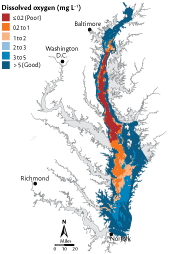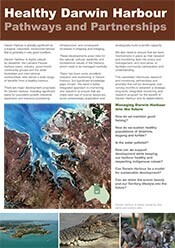Chesapeake Bay Summer Review
 EcoCheck (NOAA-UMCES partnership) has released the 2011 summer review. This year's summer conditions were influenced by high spring river flow, hot summer air temperatures, and late summer storms. Dissolved oxygen conditions were poor this summer, with the second largest volume of anoxic waters during late July in the last 25 years. Strong winds during Hurricane Irene mixed oxygen from the surface to the bottom waters during August and the volume of anoxic waters shrunk dramatically. Tropical Storm Lee brought heavy rains to an already saturated watershed, resulting in flooding of many rivers and washing tons of dirt and debris into the system. When compared to the forecast, the anoxic volume was greater than predicted for the early summer. The late summer anoxia forecast was for larger than the observed volume, which decreased due to the hurricane-driven mixing.
EcoCheck (NOAA-UMCES partnership) has released the 2011 summer review. This year's summer conditions were influenced by high spring river flow, hot summer air temperatures, and late summer storms. Dissolved oxygen conditions were poor this summer, with the second largest volume of anoxic waters during late July in the last 25 years. Strong winds during Hurricane Irene mixed oxygen from the surface to the bottom waters during August and the volume of anoxic waters shrunk dramatically. Tropical Storm Lee brought heavy rains to an already saturated watershed, resulting in flooding of many rivers and washing tons of dirt and debris into the system. When compared to the forecast, the anoxic volume was greater than predicted for the early summer. The late summer anoxia forecast was for larger than the observed volume, which decreased due to the hurricane-driven mixing.
Healthy Darwin Harbour: Pathways and Partnerships newsletter
 Darwin Harbour is globally significant as a tropical, macrotidal, monsoonal harbour that is generally in very good condition. There are major development proposals for Darwin Harbour, including significant plans for population growth, industrial expansion and resource processing infrastructure, and consequent increases in shipping and dredging. These developments pose risks for the natural, cultural, aesthetic, and recreational values of the Harbour, which need to be managed. This newsletter introduces research and monitoring partnerships and priorities that will be developed over coming months to establish a strategic, long-term, integrated monitoring and research program for the benefit of Darwin Harbour and its stakeholders.
Darwin Harbour is globally significant as a tropical, macrotidal, monsoonal harbour that is generally in very good condition. There are major development proposals for Darwin Harbour, including significant plans for population growth, industrial expansion and resource processing infrastructure, and consequent increases in shipping and dredging. These developments pose risks for the natural, cultural, aesthetic, and recreational values of the Harbour, which need to be managed. This newsletter introduces research and monitoring partnerships and priorities that will be developed over coming months to establish a strategic, long-term, integrated monitoring and research program for the benefit of Darwin Harbour and its stakeholders.
Characterization and Comparison of Stream Nutrients, Land Use, and Loading Patterns in Maryland Coastal Bay Watersheds
 This paper, published in Water, Air, & Soil Pollution 221(1-4): 255–273, discusses land use and its relation to nutrient concentrations and loading via streams in the Maryland Coastal Bays. The most significant correlation was with the land area of feeding operations. A similar relationship was also found with anthropogenic land area (cropland + urban + feeding operations). Wetland area was positively associated with hydric soils. Watersheds with the most crop agriculture had the highest nitrogen export coefficients, while the highest phosphorus export was in a watershed containing a non-operational chicken hatchery. This suggests that agricultural development, especially animal feeding operations, and landscape characteristics are important factors to understand nutrient loading.
This paper, published in Water, Air, & Soil Pollution 221(1-4): 255–273, discusses land use and its relation to nutrient concentrations and loading via streams in the Maryland Coastal Bays. The most significant correlation was with the land area of feeding operations. A similar relationship was also found with anthropogenic land area (cropland + urban + feeding operations). Wetland area was positively associated with hydric soils. Watersheds with the most crop agriculture had the highest nitrogen export coefficients, while the highest phosphorus export was in a watershed containing a non-operational chicken hatchery. This suggests that agricultural development, especially animal feeding operations, and landscape characteristics are important factors to understand nutrient loading.
New science integrator Jonathan Kellogg
 Dr. Jonathan Kellogg has recently joined IAN as a Science Integrator. Jonathan has moved with his wife from Seattle, where he earned his PhD from the University of Washington studying the amount of heat emanating from seafloor hot springs off the coast of Washington. While a graduate student, Jonathan also sought out training in science communication and was a National Science Foundation GK-12 fellow where he co-taught marine biology and earth science in a local high school. He looks forward to working with the EcoCheck team and the Mid-Atlantic Tributaries Assessment Coalition on the Chesapeake Bay and other local report cards. In their free time, Jonathan and his wife are looking forward to exploring the mountains and waters of the mid-Atlantic since they are avid hikers and boaters.
Dr. Jonathan Kellogg has recently joined IAN as a Science Integrator. Jonathan has moved with his wife from Seattle, where he earned his PhD from the University of Washington studying the amount of heat emanating from seafloor hot springs off the coast of Washington. While a graduate student, Jonathan also sought out training in science communication and was a National Science Foundation GK-12 fellow where he co-taught marine biology and earth science in a local high school. He looks forward to working with the EcoCheck team and the Mid-Atlantic Tributaries Assessment Coalition on the Chesapeake Bay and other local report cards. In their free time, Jonathan and his wife are looking forward to exploring the mountains and waters of the mid-Atlantic since they are avid hikers and boaters.

